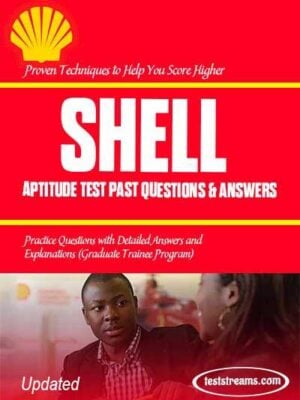Description

This NLNG scholarship Past Questions compilation helps you to prepare for NLNG Postgraduate scholarship tests conducted by Dragnet/eRecruiter. It helps you familiarize with the kind of questions you will face in the test using actual questions from previous exams.
NLNG scholarship selection is very competitive and passing the aptitude tests is critical to getting selected for the scholarship award. The test is usually conducted by Dragnet solutions or sometimes outsourced to other test proctors.
NLNG PGD Scholarship Test Format:
Like every other Dragnet administered aptitude test, you will face 3 sections on NLNG PGD Scholarship. They are:
- Numerical reasoning: Basic math principles like ratios, percentages and proportions are tested here, which also involves interpreting numerical charts and graphs.
- Verbal reasoning: Medium difficulty comprehension passages to select which two options are true or false based on the passage.
- Abstract//Diagrammatic reasoning: Involves predicting the next shape or pattern based on the logical sequence.
This pack covers the most recent dragnet tests to help you understand and familiarize with the questions pattern.
Sample questions for NLNG PGD Scholarship
Question 1
How many patients from this sample have suffered from depression in 1995?
A. 1150 patients
B. 1155 patients
C. 1375 patients
D. 1455 patients
E. 1535 patients
Correct answer: C
Explanation
55% of the 1995 sample suffered from depression. The sample consists of 2500 participants ?
0.55 = 1,375 patients suffered from depression in 1995.
Question 2
From the sample, how many less patients suffered from Bipolar disorder between 2000 and
2005?
A. 225 patients
B. 250 patients
C. 350 patients
D. 375 patients
E. 400 patients
Correct answer: B
Explanation
In 2000, 15% of the sample (2500) suffered from Bipolar disorder= 2500 x 0.15 = 375 patients. In
2005, 5% of the sample (2500) suffered from Bipolar disorder = 2500 x 0.05 = 125 patients.
375-125=250 less patients suffered from Bipolar disorder in 2005 than in 2000.
An additional way to do the math is simply look at the graph and note the difference in
percentages between 2005 and 2000 which is 10% (15-5).
10% of the entire sample (2500) is 250 and we can calculate this without making use of a
calculator
Question 3
A new revolutionary medication is introduced in 2005. This medication immediately alleviates
symptoms for 20% of the patients suffering from the 4 mental disorders presented here.
Assuming that, starting from 2005, such a treatment will be given to the original sample every 5
years with an identical success rate in percentages, how many patients comprising the sample
will remain mentally ill by the year 2020?
A. 1,024 Patients
B. 1,048 Patients
C. 1,280 Patients
D. 1,000 Patients
E. 2,000 Patients
Correct answer: A
Explanation
The medication is introduced in 2005 reducing mental illness for a sample of 2500 by 20% = 0.2 x
2500 = 500 cured patients and a total of 2000 (2500 ? 500) patients remain ill.
In 2010 another 20% will be cured from the remaining group of mentally ill people in the original
sample (2000) = 0.2 x 2000 = 400 additional patients cured and a total of 1600 (2000-400)
remaining ill.
In 2015 another 20% will be cured from a remaining sample of 1600= 0.2 x 1600 = 320 additional
patients cured and a total of 1280 (1600-320) remaining ill.
In 2020 another 20% will be cured from a remaining sample of 1280 = 0.2 x 1280 = 256 additional
patients cured and a total of 1024 (1280-256) patients still remain ill.
Question 4
In the following 15 years it is expected that the trends seen from 2000 onwards for Anxiety and
OCD will continue at the same rate. What will be the expected ratio between the two in the
year 2020?
A. 2:5
B. 1:2
C. 1:3
D. 2:3
E. 1:1
Correct answer: E
Explanation
Between 2000 to 2005 there was a reduction of 5% from 30% to 25% of patients suffering from
Anxiety.
In the same time frame the prevalence of OCD remained 10%.
Assuming this trend continues, OCD will remain constant at 10% while Anxiety is expected to
loose 5% every 5 years. i.e., drop from 25% in 2005, to 20% in 2010, to 15% in 2015, and finally to
10% in 2020.
The ratio of Anxiety to OCD in 2020 assuming the present trend continues will be 1:1
(10%:10%).
Question 5
Rate the ratio of Depression to OCD patients in the sample from largest to smallest by years.
A. 1985, 1990, 1995, 2000, 2005
B. 1990, 1985, 1995, 2005, 2000
C. 2000, 2005, 1995, 1985, 1990
D. 1990, 2000,1995, 1985,2005
E. 2000, 2005, 1985, 1990, 1995
Correct answer: B
Explanation
The Depression to OCD ratio in 1985 = 60% : 5% = 12 :1
The Depression to OCD ratio in 1990 = 65% : 5% = 13:1
The Depression to OCD ratio in 1995 = 55% : 5% = 11:1
The Depression to OCD ratio in 2000 = 45% : 10% = 4.5:1 = 9:2
The Depression to OCD ratio in 2005 = 60% : 10% = 6:1
Therefore, putting the ratio in order from largest to smallest by years = 1990, 1985, 1995, 2005,
200
Some Frequently Asked Questions About NLNG Aptitude Test 2024
Q: Can I take the test on my phone?
A: We strongly advise against using your phone for the test. Using your phone can result in your test
being terminated when calls or SMS come in during the test as this can be considered suspicious
activities (see the question on suspicious activities for more details).
Q: Can I take the test more than once?
A: You are only allowed to take the test only once. If you take the test more than once, it is only your
score from the first attempt that will be recorded.
Q: Is the test timed?
A: Yes. All tests have a time duration in which they must be completed. Once the duration is
reached, the test will be terminated, and your score recorded and submitted.
Q: What if I mistakenly end the test before I am done?
A: Once a test is submitted or closed, it will be assumed that the test has been completed and
submitted.
Q: Would I be allowed to retake the test if my test automatically ended because of network or
internet issues?
A: No, you would not be allowed to retake the test. You are advised to make sure you have quality
internet service to avoid this.
Q: Would I be allowed to use the calculator on my system for the test for mathematical questions?
A: Opening another app on your device while taking the test is considered an unusual behaviour so
we advise you have a physical calculator for the test.
Q: My test just ended. I don’t know what happened. What should I do?
A: Your test can be terminated for several reasons – internet connection, suspicious behaviour, or test
time elapsed.
Please ensure you have good and reliable internet before starting the examination to prevent
termination due to poor internet connection.
If you perform five (5) suspicious activities, your test will be terminated. Every time a suspicious
activity is noticed, you will get a warning. By the fifth (5th) warning, your test will be terminated.
Q: What are suspicious activities?
A: Your test will be terminated if you perform five (5) suspicious activities. The following activities are
considered suspicious activities /unusual behaviour:
˗ Minimizing the browser.
˗ Resizing the browser.
˗ Opening a new tab.
˗ Opening a new program.
˗ Take a screenshot. (Desktop)
˗ Pressing Ctrl + C.
˗ Pressing Ctrl + V.
˗ Pressing Print Screen.
˗ Pressing F12.
[message_box title=”REQUIRED DISCLAIMER” color=”red”]Teststreams is a global focused test-prep company. Information on our study packs are based on our in-depth research, feedback from previous test candidates and sometimes from official/privileged test resources made available by examination bodies and testing agencies.[/message_box]





Reviews
There are no reviews yet.